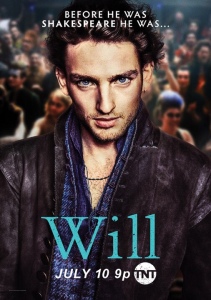On a positive note, there is a new TV show ( creator: Craig Pearce) about William Shakespeare. The star,Laurie Davidson, is a casting choice who will make women swoon.
On the other hand, there will be purist English professors who will be cringing over a number of anachronisms they believe will need correcting.
Maybe why the series is simply titled Will...because there will be English teachers who will insist on separating facts from fiction.
I suggest, however, that students will remember more if they do the background research.
For example:
- they will need to understand why Alice Burbage (for real) would have every reason to say “Yes, I am that most useless of creatures: an educated woman!”.…but would never have spoken this aloud;
- they will need to discover that Elizabethan audiences, while quite raucous, did not sport brightly dyed mohawks, and there is little evidence of iambic pentameter rap battles in taverns;
- they will need to appreciate Kit Marlowe’s place in literature;
- they will need to consider why a character Shakespeare might hide his Roman Catholic background in Elizabethan England.
What the series seems to get right is the tension created during religious purges throughout Elizabeth I’s reign. Students could do some quick research into those hostilities that were initiated by her father, Henry VIII in challenging the Roman Catholic Church. The TV series features gruesome scenes of torturing Catholics by (historically accurate) Richard Topcliffe that are hard to watch. His sadistic turn, even on the small screen, gives support to a description that he was one “whose inhuman cruelty is so great, as he will not spare to extend any torture whatsoever.”
Another right set of moments (Episode 3) center on our accepted understanding that most plot lines of Shakespeare’s plays are “borrowed” from other sources. For example, it is known that Romeo and Juliet is lifted in large part from a poem by Arthur Brooke (1562) titled The Tragicall Historye of Romeus and Iuliet. The conceit that Will collects lines on his strolls through London’s streets for later use in plays is similar to how Tom Stoppard presented Shakespeare’s style of playwriting in the Oscar winning Shakespeare in Love. But Will’s producers who try to involve Alice as a collaborator may be taking their playwriting enterprise a (London) bridge too far.
Other accurate moments from the series opener are devoted to watching a tense dynamic between playwright and actor. In one scene, famed actor Richard Burbage, played by Mattias Inwood, hams it up during lines from an early production of Edward III; he overplays lines about the futility of war as pickup lines for an attractive theatre-goer. In another scene, an out-of-control actor on stage escalates manically lewd behavior and moons the audience for laughs. Such exploitation by actors at the cost of a play’s meaning gives more support to why the real Shakespeare penned these lines for Hamlet:
“Speak the speech, I pray you, as I pronounced it to
you, trippingly on the tongue: but if you mouth it,
as many of your players do, I had as lief the
town-crier spoke my lines.”(3.2.1-4)
If teachers can see their way past the anachronisms, they may agree that Will can help students visualize a dangerous London, its alleyways teaming with treachery.
Treachery is a Shakespeare trademark, according to Harvard scholar Stephen Greenblatt in his essay in The New Yorker Magazine (July 10/17, 2017 issue) Shakespeare’s Cure for Xenophobia. In the essay, Greenblatt compares his own life experiences with the fear of the “other” or outsider that is present in Shakespeare’s Merchant of Venice.
Dangerous topics like xenophobia or plotting against the king, Greenblatt notes, are how Shakespeare “awakens” audiences to better understanding. Sounding much like the producers of Will, Greenblatt provides an allusion to King Lear,
“At a time when alehouses and inns were full of spies trolling for subversive comments,this is a playwright who could depict on the public stage a twisted sociopath lying his way to supreme authority.”
Greenblatt continues to note Shakespeare’s temerity, again referencing plot points from King Lear:
“This is a playwright who could have a character stand up and declare to the spectators that ‘a dog’s obeyed in office’.”
and then
“This is a playwright who could approvingly depict a servant mortally wounding the realm’s ruler in order to stop him from torturing a prisoner in the name of national security.”
Shakespeare, Greenblatt argues, had the audacity to produce such acts of treachery onstage in order to place us in a different point of view, a view that “offers the possibility of an escape from the mental ghettos most of us inhabit.”
In contrast, the producers of Will, keep the treachery off the stage and onto the streets.
Whether Will lasts as a TV series or ends before the season’s summer sun sets will be determined by ratings; Will currently has the distinction of being the lowest-rated TNT drama series premiere.
Will Will continue to be or not to be? That is a question.


















